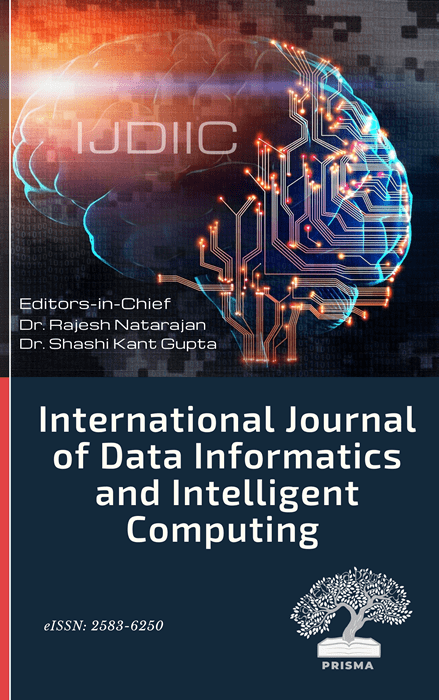Dynamic Handover Optimization Protocol to enhance energy efficiency within the A-LTE 5G network's two-tier architecture
DOI:
https://doi.org/10.59461/ijdiic.v3i3.124Keywords:
A-LTE, 5G, Handover, Mobility Management, Two-tier, Macrocell, FemtocellAbstract
Deploying small macrocell base stations, hence called femtocells, enhances the level of service provided to consumers inside as well as outside. However, the effective management of user mobility poses a significant challenge in their implementation. This paper focuses extensively on this challenge, specifically emphasizing a critical aspect of mobility management: handovers. Regarding macrocell femtocell 5G A-LTE two-tier networks, the decision-making process during handovers holds paramount importance. This research classifies and thoroughly examines decision algorithms concerning handovers, considering factors such as the speed of user equipment, financial considerations, interference, and received signal strength. Nevertheless, a significant number of these described decision algorithms overlook crucial aspects. Firstly, they often fail to account for cell selection when employing a scenario with just one macrocell and numerous femtocells; a hybrid access policy is used. Secondly, a significant number of those methods do not take the retention parameter for the user equipment into account, resulting in an increased occurrence of unnecessary handovers. To address these shortcomings, we propose a sophisticated handover decision algorithm. This novel approach considers various factors, including the individual's speed, received signal strength, time spent there, and the femtocell base station's access policy. Comparing our suggested algorithm to traditional decision algorithms that are only based on simulation, data shows that our proposed approach significantly lowers the frequency of unwanted handovers on received signal strength in the 5G network to improve the Energy Efficiency of the network by over 85%.
Downloads
References
A. Ghosh, A. Maeder, M. Baker, and D. Chandramouli, “5G Evolution: A View on 5G Cellular Technology Beyond 3GPP Release 15,” IEEE Access, vol. 7, pp. 127639–127651, 2019, doi: 10.1109/ACCESS.2019.2939938.
U. Danjuma Maiwada, A. A. Muazu, and I. K. Yakasai, “Using LTE-Sim in New Hanover Decision Algorithm for 2-Tier Macrocell-Femtocell LTE Network,” Int. J. Comput. Inf. Technol., vol. 9, no. 4, Jul. 2020, doi: 10.24203/ijcit.v9i4.20.
N. Lei and E. R. Masanet, “GLOBAL DATA CENTER ENERGY DEMAND AND STRATEGIES TO CONSERVE ENERGY,” in Data Center Handbook, Wiley, 2021, pp. 15–26. doi: 10.1002/9781119597537.ch2.
O. O. Omitola and V. M. Srivastava, “An Improved Handover Algorithm for LTE-A Femtocell Network,” J. Commun., pp. 558–565, 2020, doi: 10.12720/jcm.15.7.558-565.
Z. Zhang, Z. Junhui, S. Ni, and Y. Gong, “A Seamless Handover Scheme With Assisted eNB for 5G C/U Plane Split Heterogeneous Network,” IEEE Access, vol. 7, pp. 164256–164264, 2019, doi: 10.1109/ACCESS.2019.2952737.
J.-H. Choi and D.-J. Shin, “Generalized RACH-Less Handover for Seamless Mobility in 5G and Beyond Mobile Networks,” IEEE Wirel. Commun. Lett., vol. 8, no. 4, pp. 1264–1267, Aug. 2019, doi: 10.1109/LWC.2019.2914435.
S. R. Alkaabi, M. A. Gregory, and S. Li, “Multi-Access Edge Computing Handover Strategies, Management, and Challenges: A Review,” IEEE Access, vol. 12, pp. 4660–4673, 2024, doi: 10.1109/ACCESS.2024.3349587.
N. Aljeri and A. Boukerche, “A two-tier machine learning-based handover management scheme for intelligent vehicular networks,” Ad Hoc Networks, vol. 94, p. 101930, Nov. 2019, doi: 10.1016/j.adhoc.2019.101930.
Z. Zhang, Y. Liu, Z. Jiang, B. Yang, and J. Zhu, “An Intelligent Energy-Efficient Handover Scheme Based on CoMP for Heterogeneous Network,” IEEE Commun. Lett., vol. 28, no. 5, pp. 1221–1225, May 2024, doi: 10.1109/LCOMM.2024.3375283.
S. S. Mohite and U. D. Kolekar, “Macrocell–femtocell resource allocation via hybrid optimization algorithm,” Int. J. Intell. Unmanned Syst., vol. 10, no. 4, pp. 385–400, Nov. 2022, doi: 10.1108/IJIUS-02-2021-0013.
Q. Wu and R. Zhang, “Towards Smart and Reconfigurable Environment: Intelligent Reflecting Surface Aided Wireless Network,” IEEE Commun. Mag., vol. 58, no. 1, pp. 106–112, Jan. 2020, doi: 10.1109/MCOM.001.1900107.
DongFeng Fang; Yi Qian; Rose Qingyang Hu, “Secure and Efficient Mobility Management in 5G Wireless Networks,” in 5G Wireless Network Security and Privacy, Wiley, 2024, pp. 71–87. doi: 10.1002/9781119784340.ch6.
L. B. Makai and P. Varga, “Predicting Mobility Management Demands of Cellular Networks based on User Behavior,” in NOMS 2023-2023 IEEE/IFIP Network Operations and Management Symposium, IEEE, May 2023, pp. 1–6. doi: 10.1109/NOMS56928.2023.10154215.
S. Sonmez, I. Shayea, S. A. Khan, and A. Alhammadi, “Handover Management for Next-Generation Wireless Networks: A Brief Overview,” in 2020 IEEE Microwave Theory and Techniques in Wireless Communications (MTTW), IEEE, Oct. 2020, pp. 35–40. doi: 10.1109/MTTW51045.2020.9245065.
D. Xenakis, N. Passas, A. Radwan, J. Rodriguez, and C. Verikoukis, “Energy Efficient Mobility Management for the Macrocell – Femtocell LTE Network,” in Energy Efficiency - The Innovative Ways for Smart Energy, the Future Towards Modern Utilities, InTech, 2012. doi: 10.5772/48251.
Y. Ullah, M. Bin Roslee, S. M. Mitani, S. A. Khan, and M. H. Jusoh, “A Survey on Handover and Mobility Management in 5G HetNets: Current State, Challenges, and Future Directions,” Sensors, vol. 23, no. 11, p. 5081, May 2023, doi: 10.3390/s23115081.
M. Ayari and S. Altowaijri, “The Efficiency of Surface Impedance Technique in the Transverse Wave Approach for the EM-Modeling of Fractal-Like Tree Structure used in 5G Applications,” Eng. Technol. Appl. Sci. Res., vol. 14, no. 2, pp. 13216–13221, Apr. 2024, doi: 10.48084/etasr.6744.
Downloads
Published
How to Cite
Issue
Section
License
Copyright (c) 2024 Umar Danjuma Maiwada, Kamaluddeen Usman Danyaro, Aliza Bt Sarlan, Aminu Abdulkadir Aliyu

This work is licensed under a Creative Commons Attribution-ShareAlike 4.0 International License.








